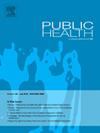The epidemiological profile and morbidity-mortality patterns of the natural hazards-related disasters in the Americas from 2000 to 2021
IF 3.9
3区 医学
Q1 PUBLIC, ENVIRONMENTAL & OCCUPATIONAL HEALTH
引用次数: 0
Abstract
Objective
To analyze the epidemiological profile of natural hazard-related disasters in the Americas between 2000 and 2021.
Study design
Cross-sectional study.
Methods
Mean and standard deviation were used to calculate the mean rates of affected individuals, injuries, and mortality per year and per million inhabitants. The ANOVA test was applied between the calculated mean rates by type of disasters. Exponential smoothing was used to forecast the number of disasters up to the year 2026.
Results
A total of 2045 natural hazard-related disasters were recorded. Of these, 81 (3.96 %) were biological, 199 (9.73 %) were climatological, 140 (6.85 %) were geophysical, 843 (41.22 %) were hydrological, and 782 (38.24 %) were meteorological. A statistically significant difference was observed between the mean injury rates per million inhabitants of natural hazard-related disasters (F = 3.40; p = 0.010). The mortality rate per million inhabitants (F = 0.43; p = 0.786) and the mean affected rate per million inhabitants (F = 0.68; p = 0.609) were not found to be statistically significant regarding the type of disaster. The results demonstrated no statistically significant decline in the mean rate of affected individuals per million inhabitants (tau = −0.086, p = 0.336), the mean mortality rate per million inhabitants (tau = −0.221, p = 0.159), and the mean rate of injuries per million inhabitants (tau = 0.169, p = 0.284).
Conclusions
Hydrological disasters had the highest mean mortality rate, biological disasters had the highest mean injury rate, and geophysical disasters had the highest mean rate of affected individuals.
2000 年至 2021 年美洲与自然灾害有关的流行病学概况和发病率-死亡率模式。
目的:分析 2000 年至 2021 年期间美洲与自然灾害有关的流行病学概况:研究设计:横断面研究:研究设计:横断面研究:采用平均值和标准差计算每年和每百万居民的受灾人数、受伤人数和死亡率的平均值。根据灾害类型对计算出的平均率进行方差分析。采用指数平滑法预测到 2026 年的灾害数量:结果:共记录了 2045 起与自然灾害相关的灾难。其中,生物灾害 81 起(3.96%),气候灾害 199 起(9.73%),地球物理灾害 140 起(6.85%),水文灾害 843 起(41.22%),气象灾害 782 起(38.24%)。在与自然灾害相关的灾害中,每百万居民平均受伤率之间存在明显的统计学差异(F = 3.40; p = 0.010)。每百万居民的死亡率 (F = 0.43; p = 0.786) 和每百万居民的平均受灾率 (F = 0.68; p = 0.609) 与灾害类型没有统计学意义。结果表明,每百万居民的平均受灾率(tau = -0.086,p = 0.336)、每百万居民的平均死亡率(tau = -0.221,p = 0.159)和每百万居民的平均受伤率(tau = 0.169,p = 0.284)在统计学上没有显著下降:结论:水文灾害的平均死亡率最高,生物灾害的平均受伤率最高,地球物理灾害的平均受灾人口率最高。
本文章由计算机程序翻译,如有差异,请以英文原文为准。
求助全文
约1分钟内获得全文
求助全文
来源期刊

Public Health
医学-公共卫生、环境卫生与职业卫生
CiteScore
7.60
自引率
0.00%
发文量
280
审稿时长
37 days
期刊介绍:
Public Health is an international, multidisciplinary peer-reviewed journal. It publishes original papers, reviews and short reports on all aspects of the science, philosophy, and practice of public health.
 求助内容:
求助内容: 应助结果提醒方式:
应助结果提醒方式:


